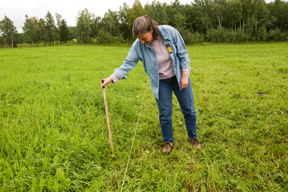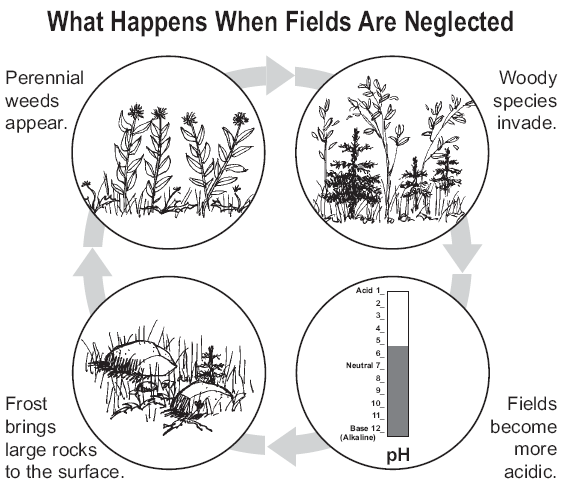Bulletin #2491, Forage Facts: This Old Hayfield: A Fact Sheet on Hayfield Renovation

By Rick Kersbergen, Extension Educator, University of Maine Cooperative Extension
Updated by Jaime Garzon, Assistant Extension Professor and Dairy Forage Educator, University of Maine Cooperative Extension
For information about UMaine Extension programs and resources, visit extension.umaine.edu.
Find more of our publications and books at extension.umaine.edu/publications/.
Many landowners want to bring abandoned or neglected hay fields back into production for quality hay or pasture. Other landowners just want to maintain the fields with desirable grasses and open spaces. To do either takes time and attention. This fact sheet briefly describes how to renovate and restore pasture lands.
The renovation process depends on many factors: site characteristics, goals for the site and resources available. To better understand what needs to be done to renovate a hayfield, let’s review what happens to neglected land.
Most hayfields are perennial sods consisting of clovers (red and white) and grasses (bluegrass, orchard grass, quackgrass, and timothy). Over time (without mowing) woody species begin to invade (alders, birches, and poplars are common). Bluegrass begins to dominate all other species. Many perennial weeds also become prevalent, including milkweed, bedstraw, dandelions and red sorrel. Without additions of limestone, soils in neglected fields become more acidic. This favors numerous weed populations, including bedstraw. Frost action may also begin to bring large rocks to the surface.
If you have time, and the field is smooth enough for your purposes, regular mowing (three times per season) plus appropriate fertilizer and lime additions will produce a good field in three to four years.

To begin the renovation process, ask yourself the following questions:
- Is there woody vegetation? Are there trees greater than two inches in diameter?
- What are the present soils? Are there wet or dry sections?
- How rough is the site? Are there rocks or severe ruts that would obstruct tractor and equipment moving through the field?
- How quickly do you want the field put back into production? One to two years? Three to four years?
- What equipment is available?
- What will be the eventual use of the field — pasture, exercise lot, hayfield, crop production or an area with scenic value?
Here are the first steps in the renovation process:
- Get a soil test done to determine fertility and lime requirements. Request a Maine Soil Testing Service container and information form from your University of Maine Cooperative Extension County Office, or from the Analytical Lab and Maine Soil Testing Service.
- Mow off the fields with a rotary mower or “Bush Hog.” This will begin to kill many woody plants and reduce the vigor of perennial weeds.
Steps to renovate an old hayfield:
- Assess the condition of the field, your goals and your resources.
- Get a soil test.
- Mow field with a rotary mower.
- Lime and fertilize.
- Remove rocks and stumps.
- Till (if necessary) and seed.
If you have time, and the field is smooth enough for your purposes, regular mowing (three times per season) plus appropriate fertilizer and lime additions will produce a good field in three to four years. Regular mowing will help improve the species composition and allow various clover species to come back into the field. If you want to introduce desirable species into the field, think about frost seeding and no-till seeding. (Cooperative Extension educators and specialists can offer advice to make either option successful.)
If the field is rough and includes stumps and large rocks, tillage operations will be necessary. This can be expensive.
Large bulldozers with rock rakes can remove large rocks and stumps without removing too much soil. Often, these rocks and stumps are then buried in the field or left in a windrow to further decompose and be removed later.
Other tillage operations will be necessary to prepare the field for seeding. If liming is needed, it should be done before the final tillage operations occur. Commercial wood ash can also be used as a liming agent. Plowing, harrowing and additional rock picking will be necessary before seeding.
Seedbeds should be firm and clean of debris. Seeding in Maine should be done either in May or during the first three weeks of August. These time periods are critical for good germination and weed control, and to allow establishment before winter. It is important to have a good seed bed and seed placement, so drill or brillion-type seeders are recommended.
If tillage is the option you choose, here are some average custom rates:1
- Plowing, $20/acre
- Harrowing, $16/acre (will need to be done at least twice)
- Seeding, $25/acre (does not include the cost of the seed)
- Lime applications @ 2 tons/ acre, $90 to $100 per acre
- Seed costs, $25 to $50/acre, depending on the seed type
1Estimates based on average costs in 2023.
Information in this publication is provided purely for educational purposes. No responsibility is assumed for any problems associated with the use of products or services mentioned. No endorsement of products or companies is intended, nor is criticism of unnamed products or companies implied.
© 2004, 2024
Call 800.287.0274 (in Maine), or 207.581.3188, for information on publications and program offerings from University of Maine Cooperative Extension, or visit extension.umaine.edu.
In complying with the letter and spirit of applicable laws and pursuing its own goals of diversity, the University of Maine System does not discriminate on the grounds of race, color, religion, sex, sexual orientation, transgender status, gender, gender identity or expression, ethnicity, national origin, citizenship status, familial status, ancestry, age, disability physical or mental, genetic information, or veterans or military status in employment, education, and all other programs and activities. The University provides reasonable accommodations to qualified individuals with disabilities upon request. The following person has been designated to handle inquiries regarding non-discrimination policies: Director of Equal Opportunity, 5713 Chadbourne Hall, Room 412, University of Maine, Orono, ME 04469-5713, 207.581.1226, TTY 711 (Maine Relay System).

